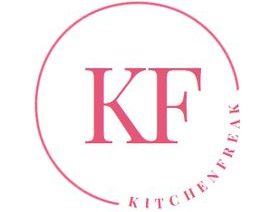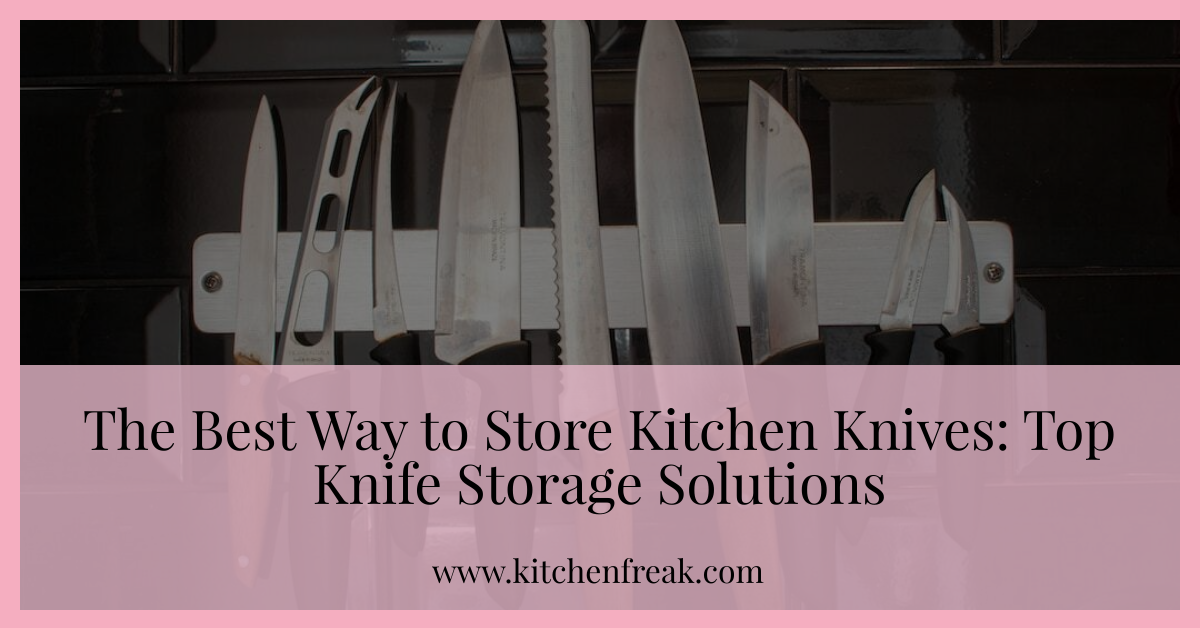Using the right, sharp knife enhances productivity and makes any activity more fun, whether you’re slicing potatoes, chopping onions, or carving an ideal rib roast. To keep both you and your kitchen knives secure and to ensure easy access when you need them, carefully store your knives.
Table of Contents
Knife Storage Ideas
Store your kitchen knives using these amazing ideas that I am going to share with you all in this blog post. So, keep reading!
The traditional knife blocks
Most home cooks keep their knife set in a knife block on the counter. My preferred method of knife storage at home is a knife block, which keeps my blades arranged and accessible on my kitchen counter. Your full collection of knives, shears, and sharpen equipment can be stored in a knife block. Knives are simple to arrange because each has a specific place, making it simple to grasp them when needed. Knife blocks can display your great collection while still looking attractive on the counter.
However, if you don’t thoroughly clean and dry the knives before inserting them back, they can also harbor bacteria. Don’t skip that step.

No-Slot Knife Block
Knife blocks don’t always include knife slots, and styles without slots are simpler to take care of and keep clean. The majority of standard-sized kitchen knives can be inserted within plastic or rubber rods because of their flexibility. For simple sanitization, you can take the complete plastic or rubber rod base off and put it in the dishwasher.
Knives are readily available, and the majority of these models are very inexpensive. Slot-less knife blocks are practical, but they also take up counter space and keep blades within reach of curious hands or paws. Additionally, the rods can easily flake off when blades aren’t inserted properly because they aren’t usually robust enough to withstand really sharp knives.
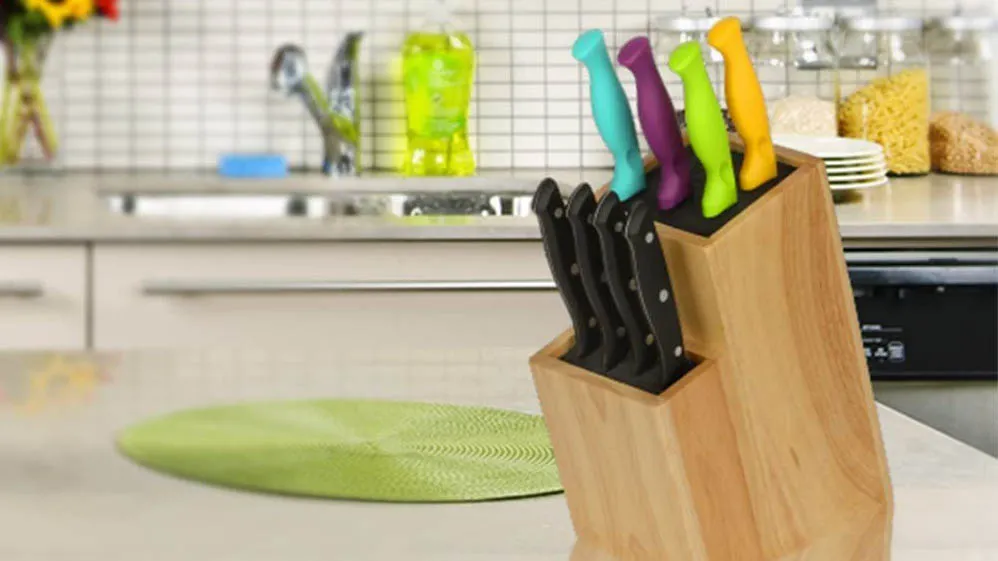
Knife roll
Another way to store your knives is to use a knife roll. Each leather roll has a specific hole where each knife can be placed horizontally to preserve the blade, and they may be kept out of the reach of kids and pets. For picnics or travel, these rolls are tough and portable. They look extremely good, too.
Since it requires a few more steps to obtain a single knife, knife rolls aren’t very practical in the kitchen. It is recommended to put your steak knives somewhere else and use the leather roll for your larger blades because they don’t provide storage for a huge collection of knives.
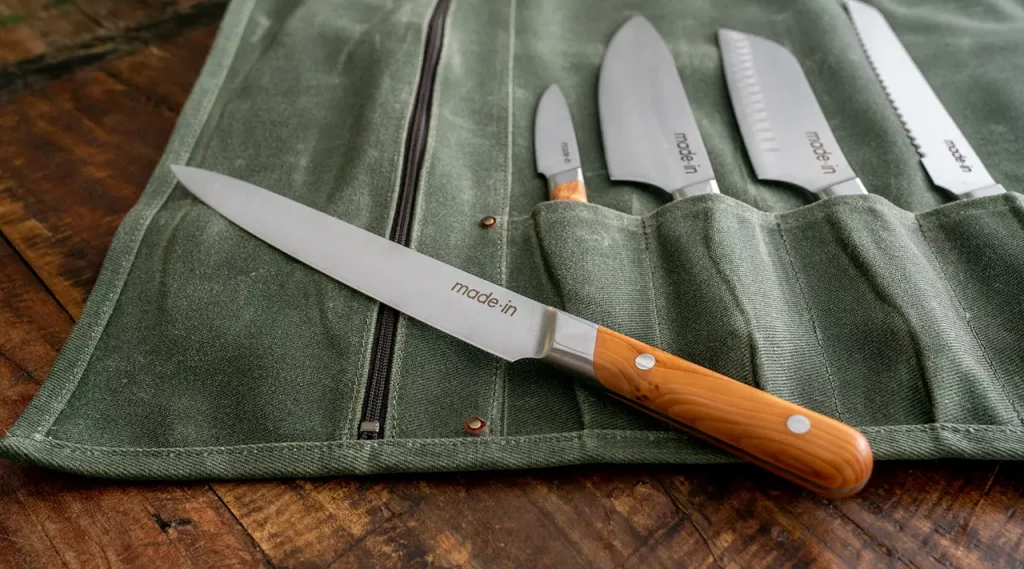
Magnetic Knife Strip
In addition to saving important counter space, magnetic strips are simple to place on kitchen walls and provide a hygienic solution to store your knives. These metal or wood magnetic strips can be installed and made usable with just a little bit of do-it-yourself.
The wall-mounted magnetic knife strip allows you to display your kitchen knives in a straight line. This tempting exhibition of absurdly sharp things could pose a risk to anyone who keeps dogs or kids at home. These strips may eventually put stress on the knives’ blades depending on the magnets’ intensity.
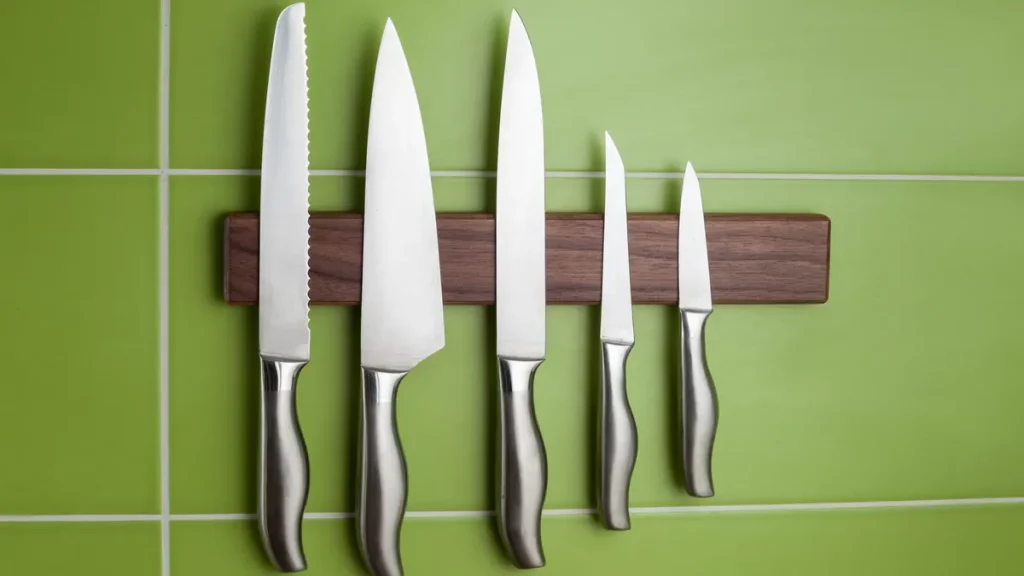
Magnetic knife block
For home cooks who want the simplicity of use of a knife block but want the simple upkeep of a magnetic strip, the magnetic knife block is the ideal mix. Knives are readily available and on show for children and animals. Your knives’ blades could potentially become dull from improper use, but happily most types are rather user-friendly.
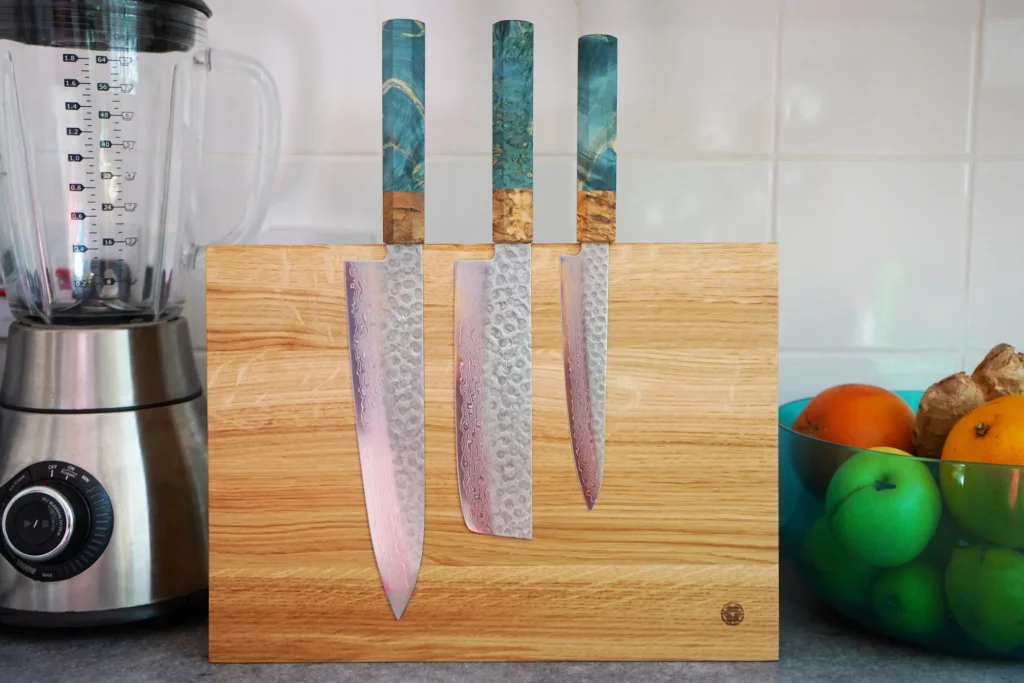
Plastic edge guard as a proven knife storage solution
Plastic knife edge guards are the finest choice if you’re seeking for a cheap solution to store your blades in a drawer. They also provide a secure and practical method of carrying your knives because the razor-sharp blade is totally hidden. Thus, providing you a way to protect yourself from sharp edges. Plastic knife guards are the least Eco-friendly choice because they are made of plastic, not metal or wood.
Dedicate a knife drawer for your knife collection
This is my favorite knife storage idea where you simply keep all your knives in a drawer storage. However, you need to be super cautious if you have kids or pets. The drawer must be out of their reach in order to avoid accidents.
In-drawer knife organizer for maximum drawer storage
Kitchen drawer-compatible knife storage options include blocks and trays with slots for straightforward arrangement. They are frequently made of walnut, maple, or bamboo. They don’t take up valuable counter space like bars do.
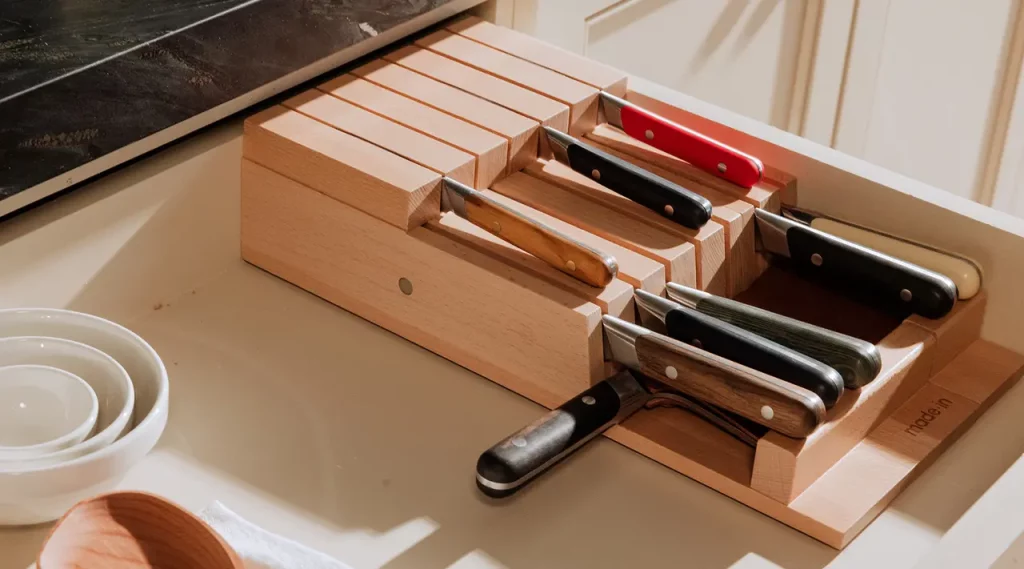
Store your chef knives at two spots
If you cook frequently and have a sizable collection of kitchen knives, you might want to store them in two different locations. According to Neat by Meg, keep the knives that are used the most frequently close to the stove while keeping the other, more specialized blades in a drawer.
Knife Sheaths to store your kitchen knives
If blocks, bars, or in-drawer organizers aren’t quite functional enough for your needs, think about concealing and cloaking your smart investment. This is another great way to store the knife blades.
Additionally, quality knife sheaths are a terrific method to safeguard your blades, particularly if they are being kept in a drawer. To ensure that my knives stay nice within the sheath, I always opt for sheaths with felt inside that does not cause damage to the blade.
How to Properly Store Knives
- Choose storage methods like magnetic strips or vertical knife blocks for clear counter space. Drawer docks free up counter space, thus keeping your knives quite accessible.
- Wooden countertop knife blocks can breed yeast and mold if knives aren’t dried or cleaned. Drawer blocks and magnetic strips are the cleanest storage options.
- Magnetic strips might attract food splatter if close to the food prep area.
- Countertop blocks or magnetic strips offer convenience as knives are easily accessible.
- Some countertop blocks and docks sharpen knives. Choose these if knife sharpness is crucial.
- Store knives blade-up to prevent dulling, regardless of the storage method.
The best way to store knives – Kitchen knife storage do’s & don’ts
Q: What are the best storage solutions for kitchen knives?
A: The best knife storage solutions include knife blocks, magnetic knife bars, drawer inserts, and countertop knife holders.
Q: Are magnetic knife bars a good storage option?
A: Magnetic knife bars are one of the most effective types of knife storage options. They save counter space and keep the knives easily accessible.
Q: Can I store my knives in a drawer?
A: Yes, you can store knives in a drawer using drawer inserts specifically designed for knife storage. This helps protect the knives and keeps them organized, even in a smaller drawer space.
Q: What are the benefits of using a knife block for storage?
A: Knife blocks provide a safe and proper knife storage solution. They keep the knives upright, protect the blades, and make it easy to grab the right knife.
Q: How many knives can I store in a knife block?
A: The number of knives a knife block can hold depends on its size and design. Most knife blocks can hold a standard set of knives, including a chef’s knife, bread knife, paring knife, and steak knives.
Q: Is a magnetic knife bar suitable for all types of knives?
A: A magnetic block is suitable for a great set of knives, including chef’s knives, paring knives, and steak knives. However, it may not be suitable for knives with a serrated edge or those made of ceramic.
Q: What are the advantages of using a drawer insert for knife storage?
A: Using a drawer insert for knife storage helps save counter space and keeps the knives organized and protected. It also allows you to store a larger number of knives compared to a knife block or magnetic knife bar.
Q: How do I choose the best knife storage option for my kitchen?
A: When choosing a knife storage option, consider factors such as available counter space, the number of knives you have, and your personal preference. Assess the pros and cons of each option and choose the one that suits your needs best.
Q: Can I store my knives in a kitchen drawer without any inserts?
A: While it is possible to store knives in a kitchen drawer without any inserts, it is not recommended. This can lead to damage to the knives and poses a safety risk when reaching into the drawer.
Anum Basit, the organizing maven and cleaning aficionado behind KitchenFreak, is a devoted stay-at-home mom with a knack for turning chaos into calm. With a passion for writing and a decade of hands-on experience managing a busy household, Anum has cultivated a deep understanding of space utilization, effective cleaning techniques, and sustainable maintenance practices. Her home has become her laboratory, where she experiments with different strategies and shares her findings on her blog.
KitchenFreak began as a way for Anum to document her journey towards creating a clutter-free, easy-to-maintain, and clean kitchen. Today, it’s a go-to resource for fellow parents and homemakers seeking practical advice on kitchen organization, maintenance, and cleaning hacks.
Anum’s expertise isn’t confined to theory; it’s steeped in real-life trials, errors, and triumphs. From discovering the best ways to organize a pantry to finding child-friendly cleaning supplies, Anum’s advice comes from her lived experiences.
Through KitchenFreak, Anum aspires to help others uncover the joy of a well-organized kitchen. Her aim is to inspire, educate, and empower her readers, showing them that no matter how messy things may get, creating a spotless kitchen is possible, one step at a time.
